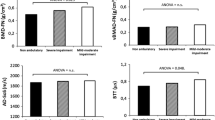Abstract
Objective: Some observations indicate that GH deficiency (GHD) may have little impact on bone mineralization in contrast to its effects on bone growth and maturation. The aim of the present study was to evaluate the effects of isolated GHD and GH-replacement therapy on bone quality assessed by a quantitative ultrasound (QUS) technique at the proximal phalanges of the hand. Design: Growth and QUS data of 68 subjects (50 males and 18 females) aged 5–18 yr with isolated GHD were retrospectively examined. A cross-sectional series of 120 observations was collected and compared with data obtained from a control population (1227 healthy children, 641 males and 586 females, aged 3–16 yr). Methods: QUS variables amplitude-dependent speed of sound (AD-SoS) and bone transmission time (BTT) were assessed by the sonographic device DBM Sonic BP IGEA. Height and weight measurements were performed according to standard techniques. In patients, skeletal age (SA) was determined by Tanner-Whitehouse method (3rd version). Results: Before treatment height, SA, AD-SoS and BTT were reduced in patients. Height SD score (SDS), SA SDS, AD-SoS SDS, and BTT SDS improved during treatment. Significant associations of both AD-SoS and BTT with age, SA, height, and therapy duration were observed. Using multivariate regression models the disease state, SA, and height proved to be significant variables in predicting BTT and AD-SoS. Conclusions: QUS measurements adjusted for body size and skeletal maturity in GHD patients seem to be only slightly reduced. A body size and skeletal maturity adjustment should be incorporated in studies on bone mass in GHD children and adolescents. A non-invasive technique such as QUS technology opens new perspectives.
Similar content being viewed by others
References
Baroncelli GI, Bertelloni S, Ceccarelli C, Saggese G. Measurement of volumetric bone mineral density accurately determines degree of lumbar undermineralization in children with growth hormone deficiency. J Clin Endocrinol Metab 1998, 83: 3150–4.
Antoniazzi F, Zamboni G, Bertoldo F, Lauriola S, Tato L Bone development during GH and GnRH analog treatment. Eur J Endocrinol 2004, 151 Suppl 1: S47–54.
Maheshwari HG, Bouillon R, Nijs J, Oganov VS, Bakulin AV, Baumann G. The impact of congenital, severe, untreated growth hormone (GH) deficiency on bone size and density in young adults: insights from genetic GH-releasing hormone receptor deficiency. J Clin Endocrinol Metab 2003, 88: 2614–8.
Wuster C, Abs R, Bengtsson BA, et al. The influence of growth hormone deficiency, growth hormone replacement therapy, and other aspects of hypopituitarism on fracture rate and bone mineral density. J Bone Miner Res 2001, 16: 398–405.
Hogler W, Briody J, Moore B, Lu PW, Cowell CT. Effect of growth hormone therapy and puberty on bone and body composition in children with idiopathic short stature and growth hormone deficiency. Bone 2005, 37: 642–50.
Barkmann R, Lusse S, Stampa B, Sakata S, Heller M, Gluer CC. Assessment of the geometry of human finger phalanges using quantitative ultrasound in vivo. Osteoporos Int 2000, 11: 745–55.
Pluskiewicz W, Luszczynska A, Halaba Z, Drozdzowska B, Sonta-Jakimczyk D. Skeletal status in survivors of childhood acute lymphoblastic leukemia assessed by quantitative ultrasound: a pilot cross-sectional study. Ultrasound Med Biol 2002, 28: 1279–84.
Saggese G, Cesaretti G. Criteria for recognition of the growth-inefficient child who may respond to treatment with growth hormone. Am J Dis Child 1989, 143: 1287–93.
Pollitzer WS, Anderson JJ. Ethnic and genetic differences in bone mass: a review with a hereditary vs environmental perspective. Am J Clin Nutr 1989, 50: 1244–59.
Tanner JM, Whitehouse RH. Clinical longitudinal standard of height, weight, height velocity, weight velocity and the stages of puberty. Arch Dis Child 1976, 51: 170–9.
Rolland-Cachera MF, Sempe M, Guilloud-Bataille M, Patois E, Pequignot-Guggenbuhl F, Fautrad V. Adiposity indices in children. Am J Clin Nutr 1982, 36: 178–84.
Tanner JM, Healy MJR, Goldstein H, Cameron N. Assessment of skeletal maturity and Prediction of Adult Height (TW3 Method). London: WB Saunders 2001: 1.
Vignolo M, Naselli A, Magliano P, Di Battista E, Aicardi M, Aicardi G. Use of the new US90 standards for TW-RUS skeletal maturity scores in youths from the Italian population. Horm Res 1999, 51: 168–72.
Glastre C, Braillon P, David L, Cochat P, Meunier PJ, Delmas PD. Measurement of bone mineral content of the lumbar spine by dual energy x-ray absorptiometry in normal children: correlations with growth parameters. J Clin Endocrinol Metab 1990, 70: 1330–3.
Boot AM, Engels MA, Boerma GJ, Krenning EP, De Muinck Keizer-Schrama SM. Changes in bone mineral density, body composition, and lipid metabolism during growth hormone (GH) treatment in children with GH deficiency. Clin Endocrinol Metab 1997, 82: 2423–8.
Baroncelli GI, Bertelloni S, Sodini F, Saggese G. Lumbar bone mineral density at final height and prevalence of fractures in treated children with growth hormone deficiency. J Clin Endocrinol Metab 2002, 87: 3624–31.
Drake WM, Carroll PV, Maher KT, et al. The effect of cessation of growth hormone (GH) therapy on bone mineral accretion in GH-deficient adolescents at the completion of linear growth. J Clin Endocrinol Metab 2003, 88: 1658–63.
Saggese G, Baroncelli GI, Bertelloni S, Bersanti S. The effect of long-term growth hormone (GH) treatment on bone mineral density in children with GH deficiency. Role of GH in the attainment of peak bone mass. J Clin Endocrinol Metab 1996, 81: 3077–83.
Author information
Authors and Affiliations
Corresponding author
Rights and permissions
About this article
Cite this article
Vignolo, M., Di Battista, E., Parodi, A. et al. Bone quality assessed by phalangeal quantitative ultrasonography in children and adolescents with isolated idiopathic growth hormone deficiency. J Endocrinol Invest 30, 445–450 (2007). https://doi.org/10.1007/BF03346326
Accepted:
Published:
Issue Date:
DOI: https://doi.org/10.1007/BF03346326




